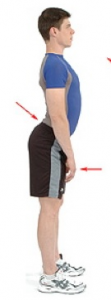 An excessive curve of the spine can manifest in certain people when the bones of the lower body align properly.
An excessive curve of the spine can manifest in certain people when the bones of the lower body align properly.
The strength and balance of your body’s musculature is determined by the arrangement of its skeleton.
The body’s muscles develop according to the way the bones relate to each other—they have no choice, literally going where they are told.
Some people are loose and others are tight.
Depending on where someone falls in the spectrum between the two will determine how sensational or difficult making postural changes will be.
In some cases, these changes have a great effect on the curve of the spine.
You can be very loose in the muscles and joints and have bad posture—someone like this will not resist changes I make in their skeletal alignment.
If they are generally loose the body will be fairly malleable and if the individual wants to take up a challenge, they can change the tone of their muscles to accommodate their new posture. It’s easier said than done, but possible.
A tight person will have a very different experience.
Someone with less flexibility will fight the realignment of the bones as the tight muscles will immediately want to return to their place of origin.
When I get the legs of someone who is too tight to move under the hips it can wreak havoc on the area between the pelvis and the ribcage creating an excessive curve of the spine.
If the muscles of the back and the hamstrings are tight when the legs move under the hips, the relationship of the muscles of the lower back and lower belly is thrown into sharp relief.
If this happens it simply means that the journey towards changing your body is a different one from the loose person. No more or less difficult; simply different.
The loose person needs to shorten and bring tone to the muscles while the tight person will have to figure out how to lengthen and open muscles that are habitually tight. It all starts with figuring out who you are and what you need.
